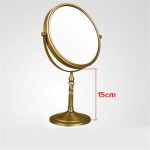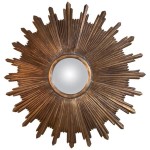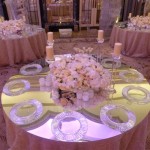Framing an Oval Mirror: A DIY Guide
Framing an oval mirror can transform a simple reflective surface into a stylish and personalized decor element. Whether the goal is to complement an existing aesthetic or to create a focal point, a custom frame allows for precise control over the mirror's appearance. This article details a comprehensive guide to crafting a frame for an oval mirror, covering material selection, construction techniques, and finishing options.
The process involves several key stages, starting with accurate measurement and design, followed by material preparation, frame assembly, and finally, secure mirror installation and surface finishing. Each step demands attention to detail to ensure a professional-looking and durable final product. This guide provides in-depth instructions to facilitate a successful DIY project, catering to varying skill levels with adaptable techniques.
Key Point 1: Measuring and Designing the Frame
The initial step in framing an oval mirror is obtaining precise measurements. Accurate dimensions are crucial for ensuring that the frame fits the mirror correctly. Use a flexible measuring tape to trace the oval’s perimeter. Because ovals are irregular shapes, it is beneficial to take several measurements at different points along the circumference to understand any variations. Record the maximum height and width to assist in calculating the required material length.
Once the mirror dimensions are recorded, the design phase begins. Consider the desired style of the frame. Options range from simple, clean lines to more ornate and decorative designs. The style should complement the surrounding decor and reflect personal preferences. Sketching a few different frame designs helps visualize the final product and identify potential challenges.
Choosing the width and thickness of the frame is also important. A wider frame makes a bold statement, while a thinner frame offers a more subtle enhancement. Similarly, the frame's thickness affects its visual weight and structural stability. Consider the mirror's size and weight to determine appropriate frame dimensions. Larger, heavier mirrors typically require thicker, more robust frames for secure support.
Software can be used to precisely render the frame. Numerous computer-aided design (CAD) programs allow for creating detailed drawings of the frame, precisely indicating all dimensions and angles. These drawings can then be used as templates for cutting the frame pieces, ensuring a high degree of accuracy. If access to a CAD program is not available, a full-size paper template will work as well.
After measurements are taken and the design is complete, calculate the total length of material needed. Add extra length to account for miter cuts and potential mistakes. This ensures sufficient material is available throughout the construction process and minimizes the risk of running short.
Key Point 2: Constructing the Oval Frame
Material selection is a critical element of the frame building process. Wood is a common choice due to its versatility, aesthetic appeal, and workability. Different types of wood, such as pine, oak, and walnut, offer varying grains, colors, and strengths. Select a wood that complements the intended design and meets the structural requirements of the frame.
Once wood has been selected, prepare the material by cutting the necessary frame pieces. This requires specialized cutting tools, given the curved elements of the oval design. One method involves creating a series of short, straight segments that approximate the curve. These segments are then joined together and sanded to create a smooth, flowing outline. Other techniques use specialized tools for creating curved cuts.
One tool suitable for straight line segmented construction is the miter saw. Each segment of the frame requires precise miter cuts to ensure a seamless transition that results in a clean oval shape. The accuracy of these cuts has a direct impact on the overall quality of the frame. Test cuts on scrap material enable one to refine the angle adjustments and achieve the desired precision.
For curved cuts, a bandsaw offers a solution. A bandsaw can create smooth, curved cuts more easily than traditional saws. Follow the template closely while cutting, maintaining a consistent line. Leaving a slight margin outside the template line enables final sanding to achieve the perfect shape. Safety is paramount when using power tools. Always wear appropriate safety gear, including eye protection and hearing protection, and adhere to the manufacturer’s safety guidelines.
Once the frame pieces are cut, join them using wood glue and fasteners. Wood glue provides a strong bond between the pieces, while fasteners, such as nails or screws, offer additional support. Clamp the frame pieces together during the drying process to ensure a tight, secure joint. Using clamps to apply even pressure across the joint will help achieve maximum strength.
After the glue has dried, sand the frame surface to create a smooth, even finish. Start with coarse-grit sandpaper to remove any imperfections and gradually progress to finer-grit sandpaper for a polished surface. Pay attention to the joints between the frame pieces, ensuring they are flush and seamless. Sanding is a critical step for achieving a professional-looking finish.
Key Point 3: Finishing and Installing the Mirror
Finishing the frame involves applying a protective coating to enhance its appearance and durability. Paint, stain, varnish, and lacquer are among the available finishing options. Each finish offers a unique aesthetic and level of protection. Choose a finish that complements the overall design and provides adequate protection against moisture and wear.
Before applying the finish, prepare the frame by cleaning it thoroughly. Remove any dust, dirt, or grease that may interfere with the adhesion of the finish. Use a tack cloth or a damp cloth to wipe down the surface. Proper preparation is essential for achieving a smooth, even finish.
When applying the finish, follow the manufacturer’s instructions carefully. Apply thin, even coats, allowing sufficient drying time between each coat. Avoid applying too much finish at once, as this can lead to runs, drips, and uneven drying. Multiple thin coats are preferable to a single thick coat.
After the finish has dried, the mirror can be installed into the frame. A variety of methods exist for securing the mirror, including using mirror clips, adhesive, or a combination of both. Mirror clips provide a secure hold and allow for easy removal if needed. Adhesive offers a seamless appearance but can make removing the mirror more challenging.
When using mirror clips, position them evenly around the perimeter of the frame, ensuring they are securely attached. The clips should hold the mirror firmly in place without applying excessive pressure. Over-tightening the clips can damage the mirror. When using adhesive, apply it sparingly to the back of the mirror and press it firmly into the frame. Use mirror-specific adhesive to prevent damage to the mirror's reflective backing. Allow the adhesive to cure completely before handling the frame.
Finally, install hanging hardware on the back of the frame. D-rings and wire are common choices for hanging mirrors. Position the D-rings symmetrically on the back of the frame, ensuring they are securely attached. Use screws or nails that are appropriate for the frame material and weight of the mirror. Attach the wire to the D-rings, ensuring it is taut and secure. Test the hanging hardware to ensure it can support the weight of the mirror before hanging it on the wall. Alternatively, keyhole hangers offer a flush mounting option.

Diy Oval Mirror Frame Domestically Speaking

Wood Dowel Mirror Frame Diy Double Arrow Designs Oval Decor

I Need An Idea To Frame My Oval Shaped Bathroom Mirrors Hometalk

15 Creative Diy Mirror Frame Ideas Home Decor Mirrors Projects

Diy Oval Mirror Frame Domestically Speaking

How To Diy Frame A Bathroom Mirror

How To Frame A Bathroom Mirror Lowe S Wall Diy Design Decor

Rattan Frame For Oval Mirror Checking In With Chelsea

Diy Oval Mirror Frame Domestically Speaking

Diy Bathroom Mirror Frame Ideas Arinsolangeathome








